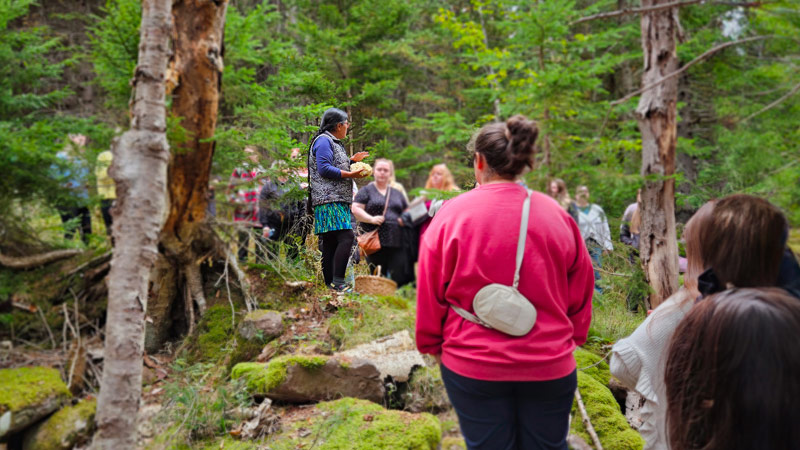New Saint John trail project celebrates Indigenous wisdom, healing and nature's resilience
Author: Angie Deveau
Posted on Nov 20, 2023
Category: UNB Saint John

Inspired by the belief that connecting with nature is crucial for mental and physical well-being, professor Rob Moir and Indigenous advisor Todd Ross of the University of New Brunswick (UNB) are collaborating on a trail project on the Saint John campus funded by the National Healing Forests Initiative.
The National Healing Forests Initiative encourages Indigenous and non-Indigenous communities, institutions and individuals to establish green spaces as Healing Forests. These spaces honour residential school victims, survivors and their families. They also honour Murdered and Missing Indigenous Women and Girls.
Moir, academic director of the Promise Partnership and the Urban & Community Studies Institute and associate professor of economics, said the project aims to reconnect with the land, pay homage to Indigenous teachings and enhance the overall quality of life on campus. He said it reflects their increasing focus on health and wellness.
“The language we use is integrated health,” he said. “When we think of that, we're looking at various things. What are nature's benefits? What are the benefits to our mental and physical health? I think this is a strong component of what we're doing.”
Moir compared the forest to a library and the original Internet and highlighted its significance in Indigenous culture. He said trees, seen as ancestors in Indigenous teachings, share wisdom through their existence and communication.
He said this perspective encourages us to view nature as a source of ancient wisdom and interconnectedness. This knowledge can guide us in understanding the natural world and our place within it.
He also pointed out that, as a society, we often overlook the natural world. This is especially true when it lacks the boundaries or walls of many constructed spaces.
“The forest existed long before human presence,” he said. “It's our responsibility to care for and appreciate it.”
Ross said UNB will use the awarded funds from the initiative to bring in Elders and assist with trail maintenance and marking.
The Healing Forest will be established on an existing trail system in a large, densely wooded area on the Saint John campus.
He explained the project includes three distinct trails, each named after an animal of cultural significance to Indigenous communities. He said the Moose Trail, the Muskrat Trail and the Pollock Trail each offer unique experiences and perspectives of the campus' natural surroundings.
Ross said a key aspect of the project was the installation of Indigenous-themed trail signs along these paths.
“These signs display the trail names in the original Indigenous language, encouraging visitors to learn and appreciate the language,” he said. “The signs feature Indigenous artwork, including the double curve motif, a design inspired by Elder Imelda Perley, to pay tribute to Indigenous traditions.”
Ross explained it is a core belief of many Indigenous cultures, particularly the Wabanaki people, that the forest is a classroom.
"It’s important for us to have access to the outdoors,” he said. “Trails provide that connection to the land, that opportunity to go out and meet our relations, which are the trees and the rocks and the animals.”
Ross also spoke about the university’s Truth and Reconciliation Strategic Action Plan and the need to promote language.
"By having Indigenous language on the trails, it's an opportunity to remind people of our connection to the Wabanaki people through language," he said. "It's also a way for us to learn some base words used on the trail."
Ross also discussed the concept of a medicine walk. This is where an Elder leads participants through the woods, sharing knowledge about traditional uses of plants, trees and natural resources.
He said through this approach, participants can gain a deeper understanding of the land, connect with their surroundings and learn about Indigenous cultures.
"The trails provide us with an opportunity to learn a bit about some of the traditional uses of the land as well as an opportunity for us to get out and have our feet in the soil to be surrounded by trees and be surrounded by nature,” he said.
Ross said the trails are significant because they connect people to Brothers Island.
“They remind us that the university is situated on Wabanaki territory, and the Indigenous presence is significant,” he said.
